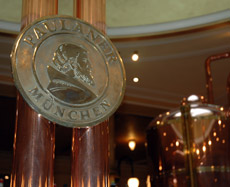 Note: This is my contribution to The Session #12: Barleywine, hosted by Jon at The Brew Site. Head on over to see what everybody else is drinking.
Note: This is my contribution to The Session #12: Barleywine, hosted by Jon at The Brew Site. Head on over to see what everybody else is drinking.
“When nothing else subsists from the past, after the people are dead, after the things are broken and scattered . . . the smell and taste of things remain poised a long time, like souls . . . bearing resiliently, on tiny and almost impalpable drops of their essence, the immense edifice of memory.”
– Marcel Proust
Scientists tell us aroma stimulations are hardwired into our memory processing center. That sounds a bit cold. I’d rather talk about Lost Abbey Angel’s Share.
When the glass is about six or eight inches from my nose it smells just like it did when I first had it at the 2006 Great American Beer Festival. A rich, complex blast of beer energy that made me pause as I started to lift the one-ounce serving to my lips. I can see brewer Tomme Arthur holding the bottle in his right hand, the recently removed cork in his left. He’s wearing a black Lost Abbey shirt, a “gotcha” smile on his face, his head particularly shiny.
 A tableau that returned to my mind last spring when I read Michael Jackson’s working introduction to Beer-Eyewitness Companions and he wrote:
A tableau that returned to my mind last spring when I read Michael Jackson’s working introduction to Beer-Eyewitness Companions and he wrote:
“Tomorrow’s classics will evolve from the currently embryonic American brews categorised by their admirers as Extreme Beers. These are the most intense-tasting beers ever produced anywhere in the world.”
I once again saw Arthur (at the right) holding that bottle. Now when I nose the beer I hear an echo of Jackson. These are the most intense-tasting beers ever produced anywhere in the world. I expect I always will.
I’d love to see his tasting notes on Angel’s Share, likely something I’d never think of. Dark dried fruit, vanilla, coconut, wood tannins, bourbon, maple syrup, brandy, caramel, toffee, molasses. We got all those flavors Wednesday evening, as well as impressions I don’t have ready adjectives for but that are firmly stamped in my memory.
We is Daria (my wife for those not regulars around here) and I. We spent going on two hours with the beer, chatting about travel plans much more than flavors. But each time we revisited Angel’s Share there was something new. It’s a contemplative beer, but you don’t have to spend all your time contemplating it.
Still, questions came to mind. And, via e-mail, Arthur had answers.
Just the facts
This batch released in November spent eight months in oak barrels that once held brandy. It’s 11.5% abv. The next batch will be one aged in bourbon barrels. Unlike the first two batches, sold in 750ml bottles, that one will be in 375s.
The base was brewed just for this project, but on its own is closer “to style” than many Lost Abbey beers. That style would be English barley wine (though a strong one even before the barrels boost the abv). It’s a reminder that it takes a great beer at the center for a barrel-aged beer to be great.
Now the soul
Which came first, the beer or the barrels?
“The Beer came first. The same base beer was used to create our Late Harvest 15th Anniversary Ale for Pizza Port Solana Beach in 2002. We have never served the base beer on its own although it is quite the little number even without the barrel aging. When we secured the brandy barrels, I had a feeling these flavors were more in line with what I was expecting back in 2002. In this way, the beer soars in a way the other could not. Although, I am very partial to the Late Harvest for its inclusion of grapes and barrel aging properties.”
Do you feel growing pressure with each release?
“I think in many ways, this is one beer that I am completely at peace with. It doesn’t require microbial dispositions and as long as we’re able to secure new oak for the aging on a regular basis, I feel confident in our ability to get this one in the bottle at the highest level with the flavors we’ve come to expect from this beer. There is a heightened sense of drama (per se) with each new consumer and their expectations of flavor towards this beer. It is the highest rated barley wine on Rate Beer right now and that brings with it a whole flooded fields worth of concern. This concern manifests itself in a ‘I sure hope I haven’t let the consumer down’ sort of way.”
Can a beer like this be too intense? Where’s the balance?
“I think that every beer has its breaking points. One of the reasons we went to the smaller format was to give consumers the opportunity to not have to consume large amounts of a sipping beer. For me, I don’t see this beer as being too intense. I think the balance is derived in flavor acquisition and maturation . . . ie when we start the uptake of brandy flavors from the wood and marry them to the sweetness of the beer, we see the maturation from oxidation and subtle integration of the nuances involved. In this way, we take a great beer and make it better as long as we don’t burden the beer and force it to walk in the shadow of the oak basis we’ve applied.”
These are the most intense-tasting beers ever produced anywhere in the world.
 I think I need to talk to New Glarus brewmaster Dan Carey, and finish a conversation started 11 years ago.
I think I need to talk to New Glarus brewmaster Dan Carey, and finish a conversation started 11 years ago.  Those of us just now emerging from a
Those of us just now emerging from a  A tableau that returned to my mind last spring when I read Michael Jackson’s working introduction to
A tableau that returned to my mind last spring when I read Michael Jackson’s working introduction to  Now this is getting personal.
Now this is getting personal.